The Impact of Microwave Heating on Food Quality and Human Health
VerifiedAdded on 2021/04/17
|9
|2405
|22
Report
AI Summary
This report provides a comprehensive overview of microwave heating technology in food science, exploring its history, current developments, and applications. It delves into the process design and equipment used in microwave ovens, highlighting advancements in the field. The report discusses the impact of microwave heating on food quality and safety, addressing concerns about nutrient preservation and potential risks. Furthermore, it compares microwave technology with emerging methods like ultrasound for food processing and preservation. The report concludes by summarizing the benefits and limitations of microwave heating, emphasizing its role in modern food technology and the importance of understanding its effects on human health and food quality. The document is a student assignment available on Desklib, the platform for AI-powered study tools.
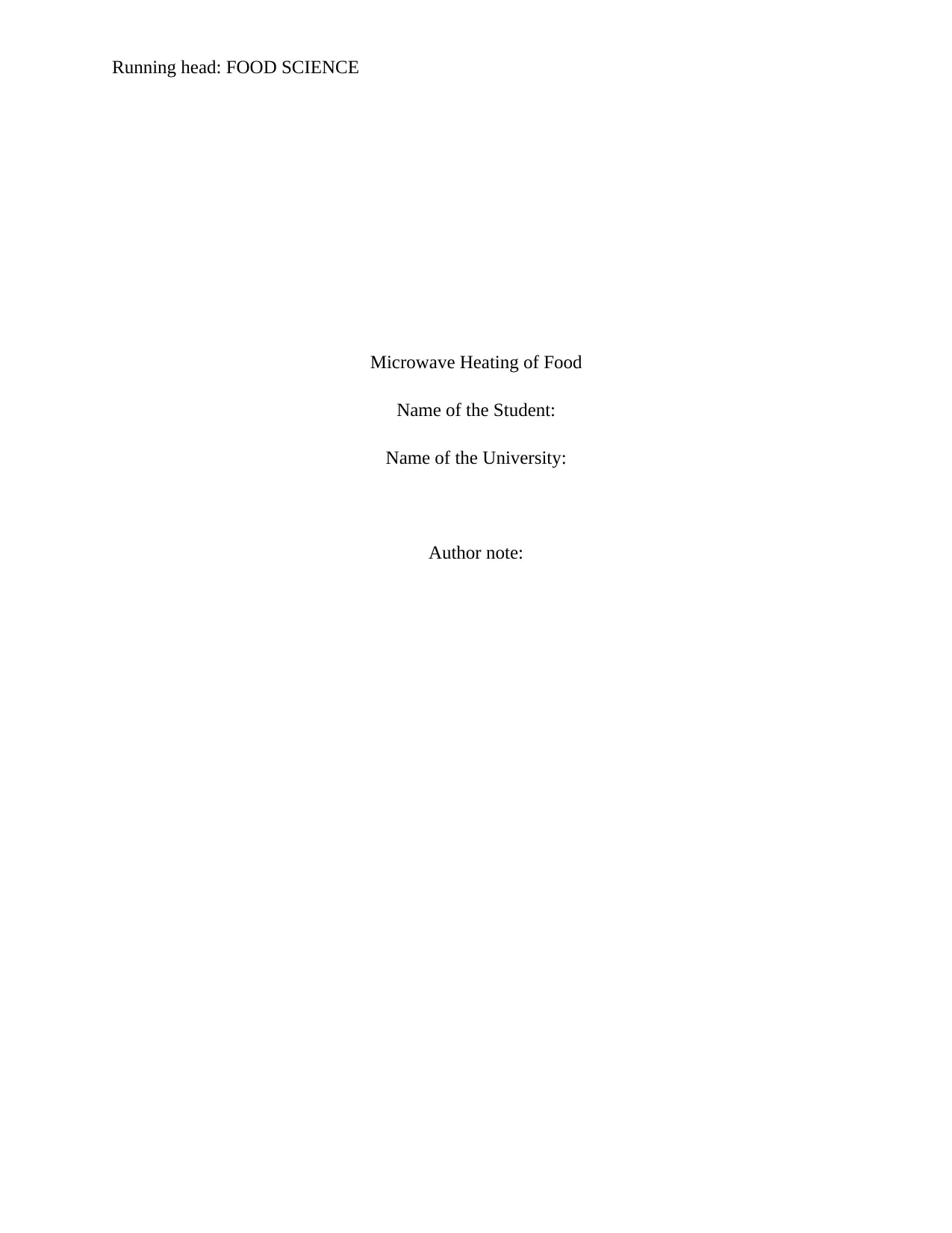
Running head: FOOD SCIENCE
Microwave Heating of Food
Name of the Student:
Name of the University:
Author note:
Microwave Heating of Food
Name of the Student:
Name of the University:
Author note:
Paraphrase This Document
Need a fresh take? Get an instant paraphrase of this document with our AI Paraphraser
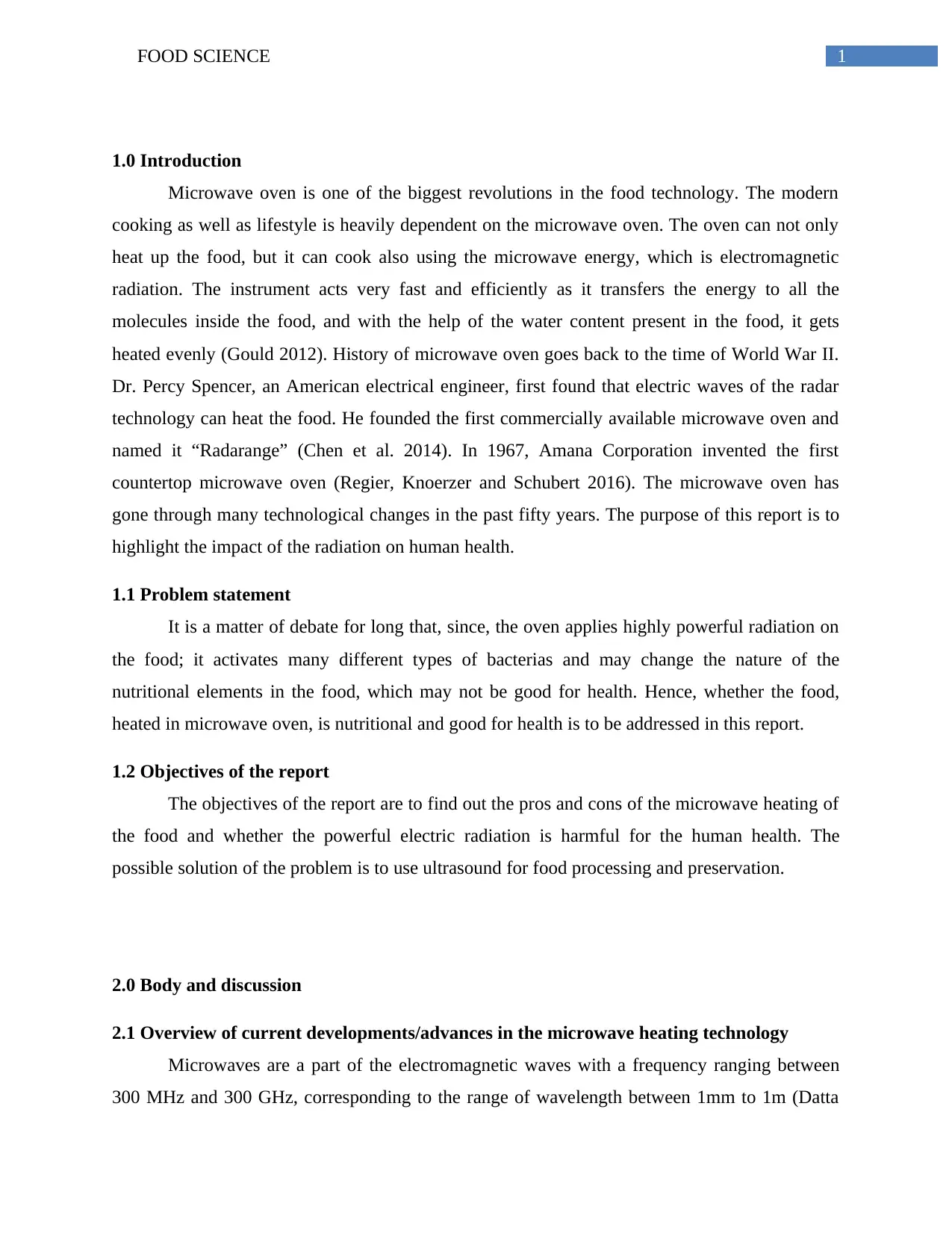
1FOOD SCIENCE
1.0 Introduction
Microwave oven is one of the biggest revolutions in the food technology. The modern
cooking as well as lifestyle is heavily dependent on the microwave oven. The oven can not only
heat up the food, but it can cook also using the microwave energy, which is electromagnetic
radiation. The instrument acts very fast and efficiently as it transfers the energy to all the
molecules inside the food, and with the help of the water content present in the food, it gets
heated evenly (Gould 2012). History of microwave oven goes back to the time of World War II.
Dr. Percy Spencer, an American electrical engineer, first found that electric waves of the radar
technology can heat the food. He founded the first commercially available microwave oven and
named it “Radarange” (Chen et al. 2014). In 1967, Amana Corporation invented the first
countertop microwave oven (Regier, Knoerzer and Schubert 2016). The microwave oven has
gone through many technological changes in the past fifty years. The purpose of this report is to
highlight the impact of the radiation on human health.
1.1 Problem statement
It is a matter of debate for long that, since, the oven applies highly powerful radiation on
the food; it activates many different types of bacterias and may change the nature of the
nutritional elements in the food, which may not be good for health. Hence, whether the food,
heated in microwave oven, is nutritional and good for health is to be addressed in this report.
1.2 Objectives of the report
The objectives of the report are to find out the pros and cons of the microwave heating of
the food and whether the powerful electric radiation is harmful for the human health. The
possible solution of the problem is to use ultrasound for food processing and preservation.
2.0 Body and discussion
2.1 Overview of current developments/advances in the microwave heating technology
Microwaves are a part of the electromagnetic waves with a frequency ranging between
300 MHz and 300 GHz, corresponding to the range of wavelength between 1mm to 1m (Datta
1.0 Introduction
Microwave oven is one of the biggest revolutions in the food technology. The modern
cooking as well as lifestyle is heavily dependent on the microwave oven. The oven can not only
heat up the food, but it can cook also using the microwave energy, which is electromagnetic
radiation. The instrument acts very fast and efficiently as it transfers the energy to all the
molecules inside the food, and with the help of the water content present in the food, it gets
heated evenly (Gould 2012). History of microwave oven goes back to the time of World War II.
Dr. Percy Spencer, an American electrical engineer, first found that electric waves of the radar
technology can heat the food. He founded the first commercially available microwave oven and
named it “Radarange” (Chen et al. 2014). In 1967, Amana Corporation invented the first
countertop microwave oven (Regier, Knoerzer and Schubert 2016). The microwave oven has
gone through many technological changes in the past fifty years. The purpose of this report is to
highlight the impact of the radiation on human health.
1.1 Problem statement
It is a matter of debate for long that, since, the oven applies highly powerful radiation on
the food; it activates many different types of bacterias and may change the nature of the
nutritional elements in the food, which may not be good for health. Hence, whether the food,
heated in microwave oven, is nutritional and good for health is to be addressed in this report.
1.2 Objectives of the report
The objectives of the report are to find out the pros and cons of the microwave heating of
the food and whether the powerful electric radiation is harmful for the human health. The
possible solution of the problem is to use ultrasound for food processing and preservation.
2.0 Body and discussion
2.1 Overview of current developments/advances in the microwave heating technology
Microwaves are a part of the electromagnetic waves with a frequency ranging between
300 MHz and 300 GHz, corresponding to the range of wavelength between 1mm to 1m (Datta
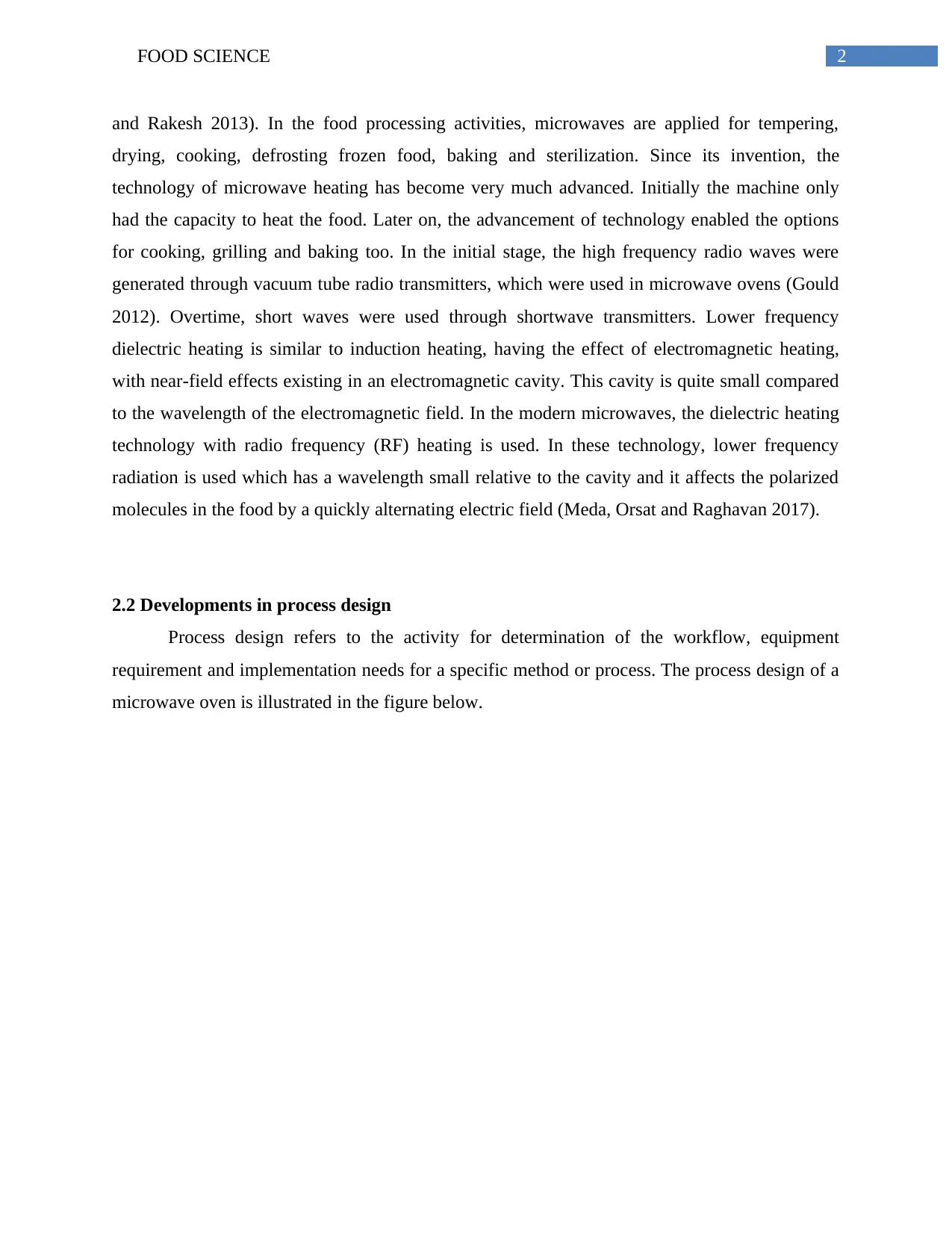
2FOOD SCIENCE
and Rakesh 2013). In the food processing activities, microwaves are applied for tempering,
drying, cooking, defrosting frozen food, baking and sterilization. Since its invention, the
technology of microwave heating has become very much advanced. Initially the machine only
had the capacity to heat the food. Later on, the advancement of technology enabled the options
for cooking, grilling and baking too. In the initial stage, the high frequency radio waves were
generated through vacuum tube radio transmitters, which were used in microwave ovens (Gould
2012). Overtime, short waves were used through shortwave transmitters. Lower frequency
dielectric heating is similar to induction heating, having the effect of electromagnetic heating,
with near-field effects existing in an electromagnetic cavity. This cavity is quite small compared
to the wavelength of the electromagnetic field. In the modern microwaves, the dielectric heating
technology with radio frequency (RF) heating is used. In these technology, lower frequency
radiation is used which has a wavelength small relative to the cavity and it affects the polarized
molecules in the food by a quickly alternating electric field (Meda, Orsat and Raghavan 2017).
2.2 Developments in process design
Process design refers to the activity for determination of the workflow, equipment
requirement and implementation needs for a specific method or process. The process design of a
microwave oven is illustrated in the figure below.
and Rakesh 2013). In the food processing activities, microwaves are applied for tempering,
drying, cooking, defrosting frozen food, baking and sterilization. Since its invention, the
technology of microwave heating has become very much advanced. Initially the machine only
had the capacity to heat the food. Later on, the advancement of technology enabled the options
for cooking, grilling and baking too. In the initial stage, the high frequency radio waves were
generated through vacuum tube radio transmitters, which were used in microwave ovens (Gould
2012). Overtime, short waves were used through shortwave transmitters. Lower frequency
dielectric heating is similar to induction heating, having the effect of electromagnetic heating,
with near-field effects existing in an electromagnetic cavity. This cavity is quite small compared
to the wavelength of the electromagnetic field. In the modern microwaves, the dielectric heating
technology with radio frequency (RF) heating is used. In these technology, lower frequency
radiation is used which has a wavelength small relative to the cavity and it affects the polarized
molecules in the food by a quickly alternating electric field (Meda, Orsat and Raghavan 2017).
2.2 Developments in process design
Process design refers to the activity for determination of the workflow, equipment
requirement and implementation needs for a specific method or process. The process design of a
microwave oven is illustrated in the figure below.
⊘ This is a preview!⊘
Do you want full access?
Subscribe today to unlock all pages.

Trusted by 1+ million students worldwide
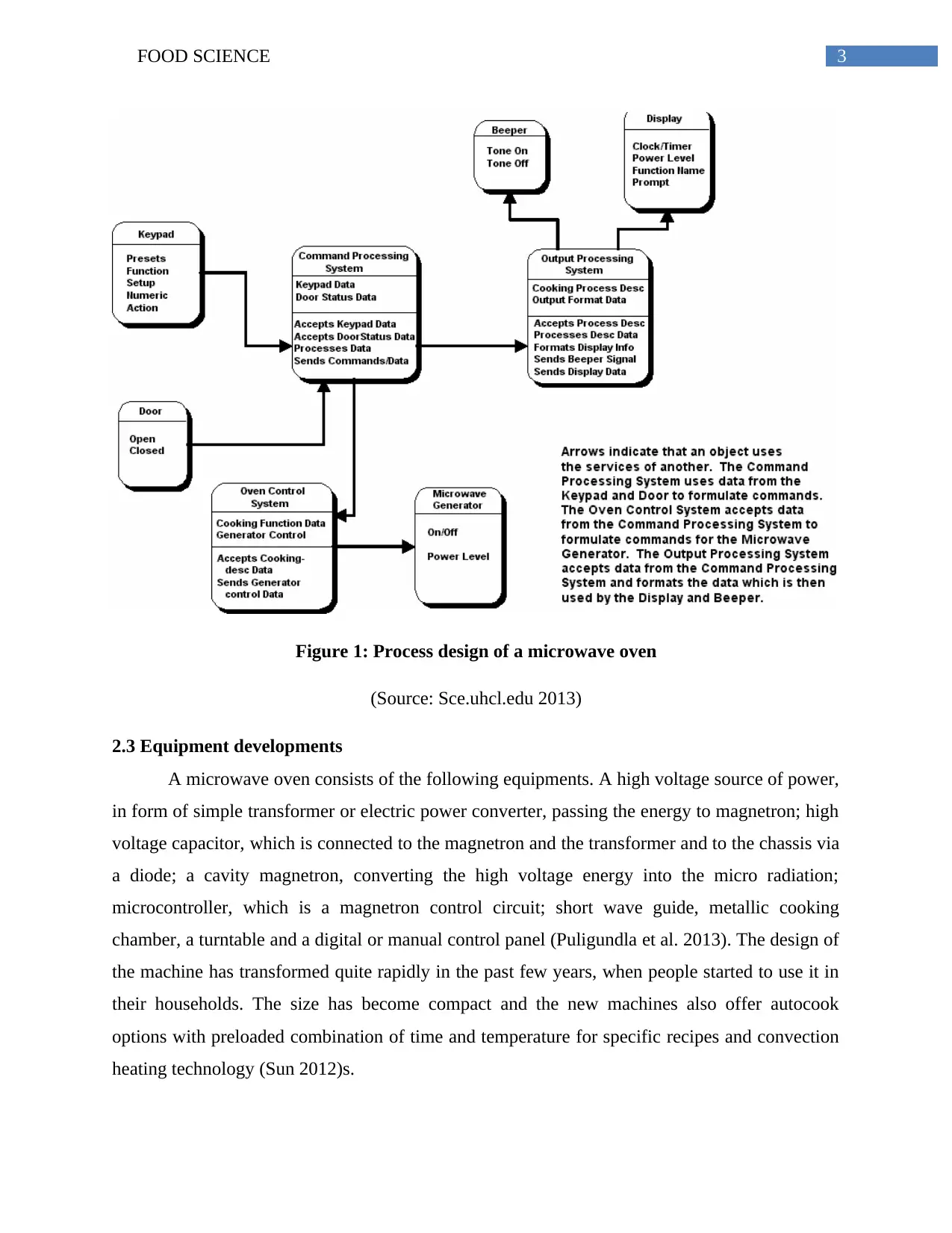
3FOOD SCIENCE
Figure 1: Process design of a microwave oven
(Source: Sce.uhcl.edu 2013)
2.3 Equipment developments
A microwave oven consists of the following equipments. A high voltage source of power,
in form of simple transformer or electric power converter, passing the energy to magnetron; high
voltage capacitor, which is connected to the magnetron and the transformer and to the chassis via
a diode; a cavity magnetron, converting the high voltage energy into the micro radiation;
microcontroller, which is a magnetron control circuit; short wave guide, metallic cooking
chamber, a turntable and a digital or manual control panel (Puligundla et al. 2013). The design of
the machine has transformed quite rapidly in the past few years, when people started to use it in
their households. The size has become compact and the new machines also offer autocook
options with preloaded combination of time and temperature for specific recipes and convection
heating technology (Sun 2012)s.
Figure 1: Process design of a microwave oven
(Source: Sce.uhcl.edu 2013)
2.3 Equipment developments
A microwave oven consists of the following equipments. A high voltage source of power,
in form of simple transformer or electric power converter, passing the energy to magnetron; high
voltage capacitor, which is connected to the magnetron and the transformer and to the chassis via
a diode; a cavity magnetron, converting the high voltage energy into the micro radiation;
microcontroller, which is a magnetron control circuit; short wave guide, metallic cooking
chamber, a turntable and a digital or manual control panel (Puligundla et al. 2013). The design of
the machine has transformed quite rapidly in the past few years, when people started to use it in
their households. The size has become compact and the new machines also offer autocook
options with preloaded combination of time and temperature for specific recipes and convection
heating technology (Sun 2012)s.
Paraphrase This Document
Need a fresh take? Get an instant paraphrase of this document with our AI Paraphraser
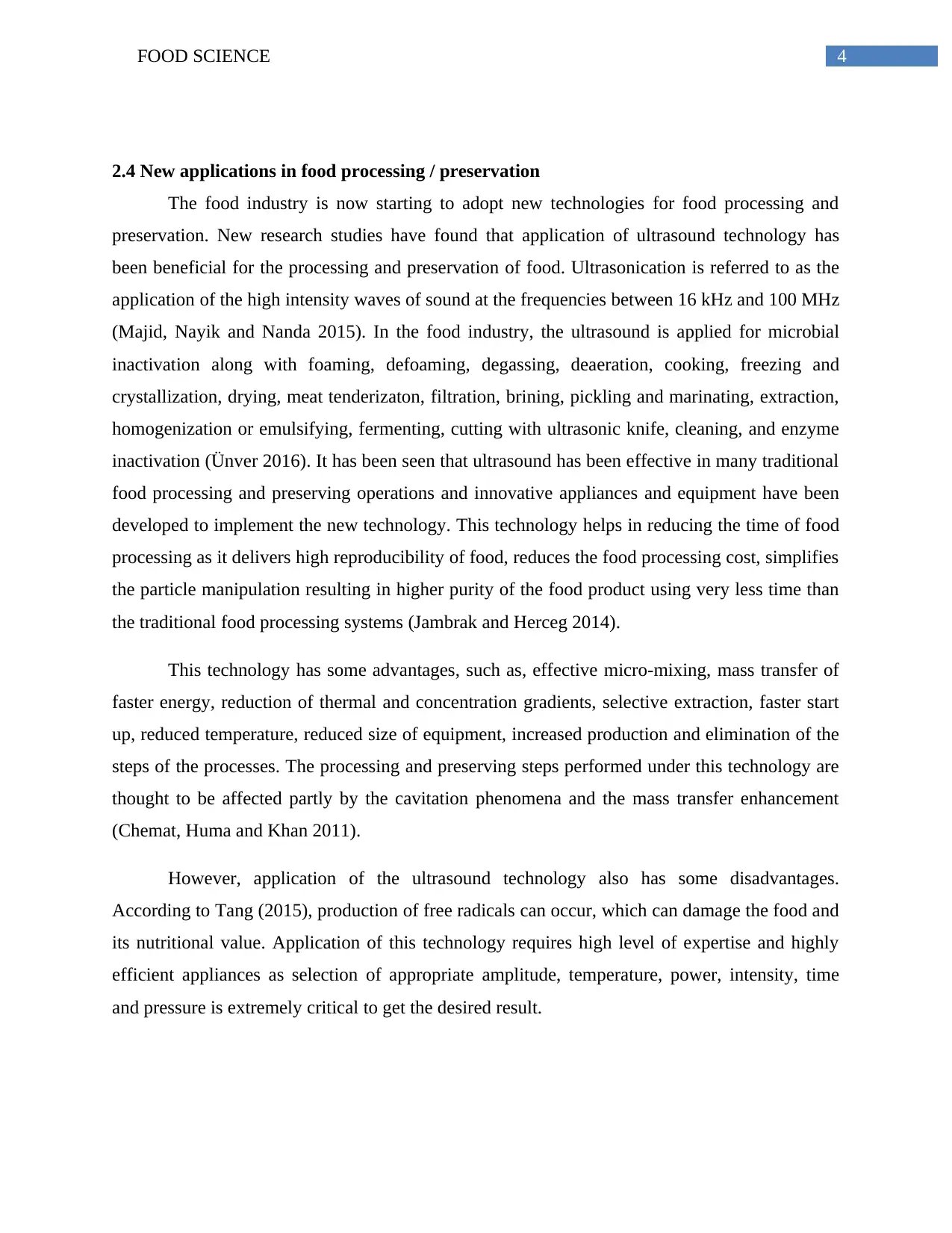
4FOOD SCIENCE
2.4 New applications in food processing / preservation
The food industry is now starting to adopt new technologies for food processing and
preservation. New research studies have found that application of ultrasound technology has
been beneficial for the processing and preservation of food. Ultrasonication is referred to as the
application of the high intensity waves of sound at the frequencies between 16 kHz and 100 MHz
(Majid, Nayik and Nanda 2015). In the food industry, the ultrasound is applied for microbial
inactivation along with foaming, defoaming, degassing, deaeration, cooking, freezing and
crystallization, drying, meat tenderizaton, filtration, brining, pickling and marinating, extraction,
homogenization or emulsifying, fermenting, cutting with ultrasonic knife, cleaning, and enzyme
inactivation (Ünver 2016). It has been seen that ultrasound has been effective in many traditional
food processing and preserving operations and innovative appliances and equipment have been
developed to implement the new technology. This technology helps in reducing the time of food
processing as it delivers high reproducibility of food, reduces the food processing cost, simplifies
the particle manipulation resulting in higher purity of the food product using very less time than
the traditional food processing systems (Jambrak and Herceg 2014).
This technology has some advantages, such as, effective micro-mixing, mass transfer of
faster energy, reduction of thermal and concentration gradients, selective extraction, faster start
up, reduced temperature, reduced size of equipment, increased production and elimination of the
steps of the processes. The processing and preserving steps performed under this technology are
thought to be affected partly by the cavitation phenomena and the mass transfer enhancement
(Chemat, Huma and Khan 2011).
However, application of the ultrasound technology also has some disadvantages.
According to Tang (2015), production of free radicals can occur, which can damage the food and
its nutritional value. Application of this technology requires high level of expertise and highly
efficient appliances as selection of appropriate amplitude, temperature, power, intensity, time
and pressure is extremely critical to get the desired result.
2.4 New applications in food processing / preservation
The food industry is now starting to adopt new technologies for food processing and
preservation. New research studies have found that application of ultrasound technology has
been beneficial for the processing and preservation of food. Ultrasonication is referred to as the
application of the high intensity waves of sound at the frequencies between 16 kHz and 100 MHz
(Majid, Nayik and Nanda 2015). In the food industry, the ultrasound is applied for microbial
inactivation along with foaming, defoaming, degassing, deaeration, cooking, freezing and
crystallization, drying, meat tenderizaton, filtration, brining, pickling and marinating, extraction,
homogenization or emulsifying, fermenting, cutting with ultrasonic knife, cleaning, and enzyme
inactivation (Ünver 2016). It has been seen that ultrasound has been effective in many traditional
food processing and preserving operations and innovative appliances and equipment have been
developed to implement the new technology. This technology helps in reducing the time of food
processing as it delivers high reproducibility of food, reduces the food processing cost, simplifies
the particle manipulation resulting in higher purity of the food product using very less time than
the traditional food processing systems (Jambrak and Herceg 2014).
This technology has some advantages, such as, effective micro-mixing, mass transfer of
faster energy, reduction of thermal and concentration gradients, selective extraction, faster start
up, reduced temperature, reduced size of equipment, increased production and elimination of the
steps of the processes. The processing and preserving steps performed under this technology are
thought to be affected partly by the cavitation phenomena and the mass transfer enhancement
(Chemat, Huma and Khan 2011).
However, application of the ultrasound technology also has some disadvantages.
According to Tang (2015), production of free radicals can occur, which can damage the food and
its nutritional value. Application of this technology requires high level of expertise and highly
efficient appliances as selection of appropriate amplitude, temperature, power, intensity, time
and pressure is extremely critical to get the desired result.
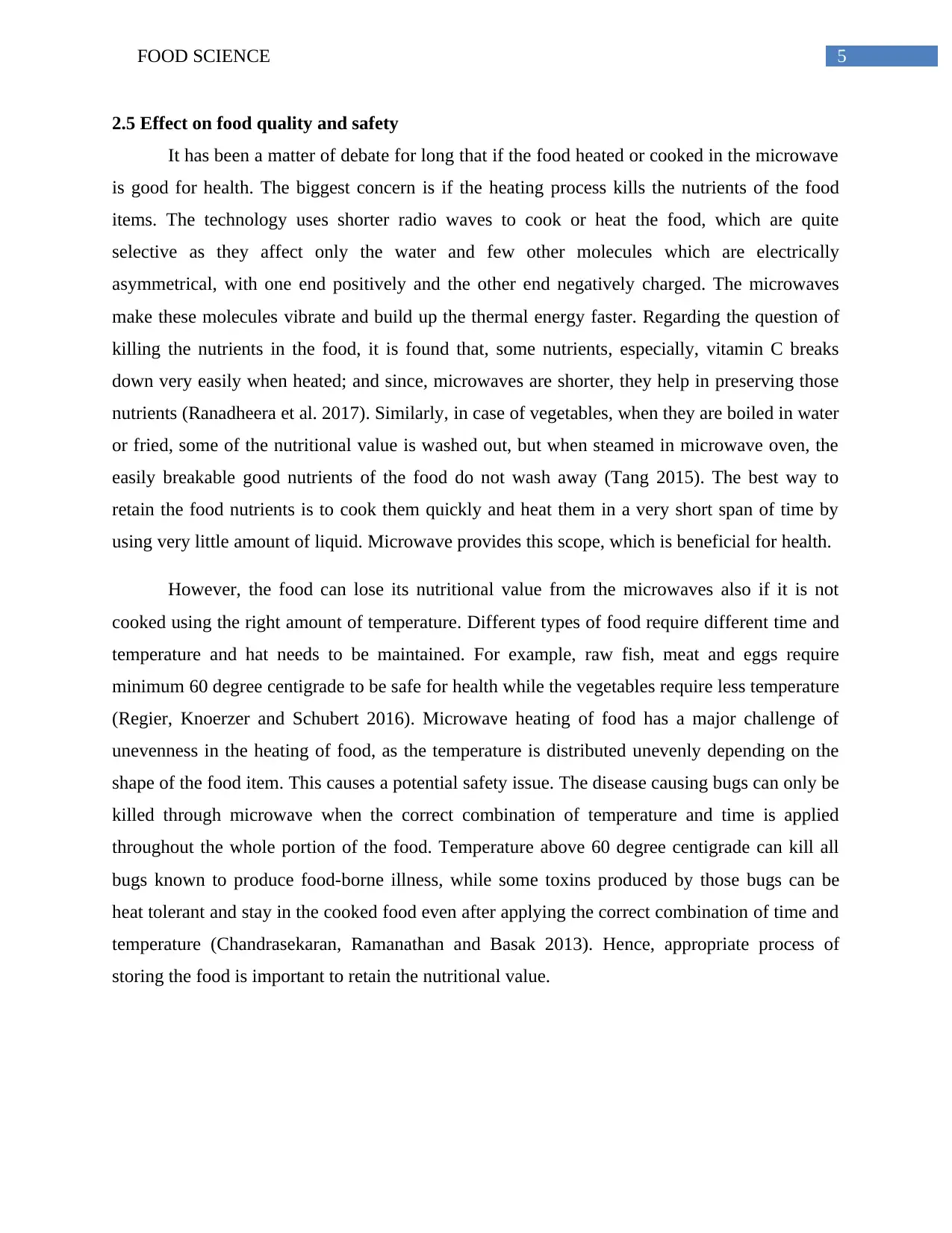
5FOOD SCIENCE
2.5 Effect on food quality and safety
It has been a matter of debate for long that if the food heated or cooked in the microwave
is good for health. The biggest concern is if the heating process kills the nutrients of the food
items. The technology uses shorter radio waves to cook or heat the food, which are quite
selective as they affect only the water and few other molecules which are electrically
asymmetrical, with one end positively and the other end negatively charged. The microwaves
make these molecules vibrate and build up the thermal energy faster. Regarding the question of
killing the nutrients in the food, it is found that, some nutrients, especially, vitamin C breaks
down very easily when heated; and since, microwaves are shorter, they help in preserving those
nutrients (Ranadheera et al. 2017). Similarly, in case of vegetables, when they are boiled in water
or fried, some of the nutritional value is washed out, but when steamed in microwave oven, the
easily breakable good nutrients of the food do not wash away (Tang 2015). The best way to
retain the food nutrients is to cook them quickly and heat them in a very short span of time by
using very little amount of liquid. Microwave provides this scope, which is beneficial for health.
However, the food can lose its nutritional value from the microwaves also if it is not
cooked using the right amount of temperature. Different types of food require different time and
temperature and hat needs to be maintained. For example, raw fish, meat and eggs require
minimum 60 degree centigrade to be safe for health while the vegetables require less temperature
(Regier, Knoerzer and Schubert 2016). Microwave heating of food has a major challenge of
unevenness in the heating of food, as the temperature is distributed unevenly depending on the
shape of the food item. This causes a potential safety issue. The disease causing bugs can only be
killed through microwave when the correct combination of temperature and time is applied
throughout the whole portion of the food. Temperature above 60 degree centigrade can kill all
bugs known to produce food-borne illness, while some toxins produced by those bugs can be
heat tolerant and stay in the cooked food even after applying the correct combination of time and
temperature (Chandrasekaran, Ramanathan and Basak 2013). Hence, appropriate process of
storing the food is important to retain the nutritional value.
2.5 Effect on food quality and safety
It has been a matter of debate for long that if the food heated or cooked in the microwave
is good for health. The biggest concern is if the heating process kills the nutrients of the food
items. The technology uses shorter radio waves to cook or heat the food, which are quite
selective as they affect only the water and few other molecules which are electrically
asymmetrical, with one end positively and the other end negatively charged. The microwaves
make these molecules vibrate and build up the thermal energy faster. Regarding the question of
killing the nutrients in the food, it is found that, some nutrients, especially, vitamin C breaks
down very easily when heated; and since, microwaves are shorter, they help in preserving those
nutrients (Ranadheera et al. 2017). Similarly, in case of vegetables, when they are boiled in water
or fried, some of the nutritional value is washed out, but when steamed in microwave oven, the
easily breakable good nutrients of the food do not wash away (Tang 2015). The best way to
retain the food nutrients is to cook them quickly and heat them in a very short span of time by
using very little amount of liquid. Microwave provides this scope, which is beneficial for health.
However, the food can lose its nutritional value from the microwaves also if it is not
cooked using the right amount of temperature. Different types of food require different time and
temperature and hat needs to be maintained. For example, raw fish, meat and eggs require
minimum 60 degree centigrade to be safe for health while the vegetables require less temperature
(Regier, Knoerzer and Schubert 2016). Microwave heating of food has a major challenge of
unevenness in the heating of food, as the temperature is distributed unevenly depending on the
shape of the food item. This causes a potential safety issue. The disease causing bugs can only be
killed through microwave when the correct combination of temperature and time is applied
throughout the whole portion of the food. Temperature above 60 degree centigrade can kill all
bugs known to produce food-borne illness, while some toxins produced by those bugs can be
heat tolerant and stay in the cooked food even after applying the correct combination of time and
temperature (Chandrasekaran, Ramanathan and Basak 2013). Hence, appropriate process of
storing the food is important to retain the nutritional value.
⊘ This is a preview!⊘
Do you want full access?
Subscribe today to unlock all pages.

Trusted by 1+ million students worldwide
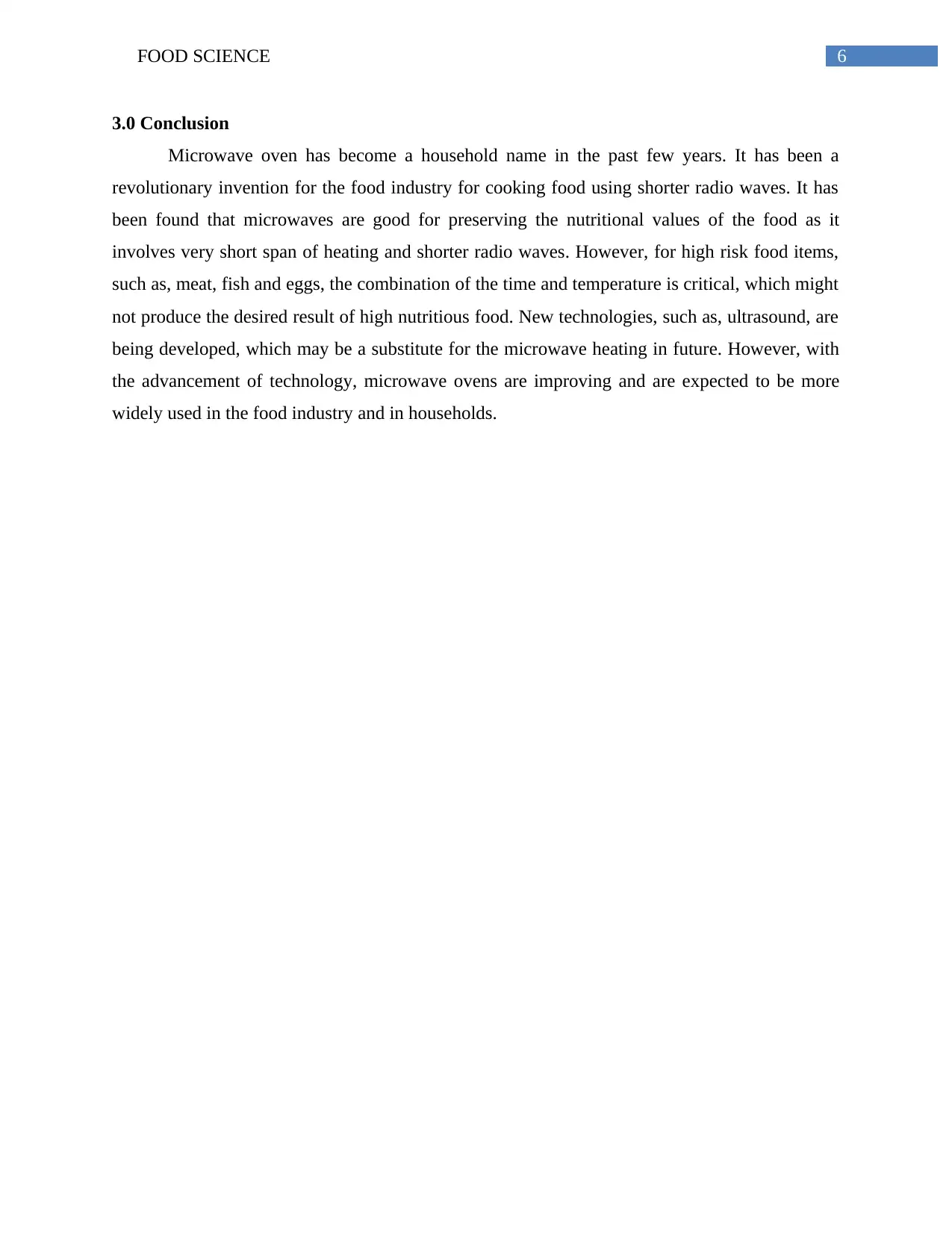
6FOOD SCIENCE
3.0 Conclusion
Microwave oven has become a household name in the past few years. It has been a
revolutionary invention for the food industry for cooking food using shorter radio waves. It has
been found that microwaves are good for preserving the nutritional values of the food as it
involves very short span of heating and shorter radio waves. However, for high risk food items,
such as, meat, fish and eggs, the combination of the time and temperature is critical, which might
not produce the desired result of high nutritious food. New technologies, such as, ultrasound, are
being developed, which may be a substitute for the microwave heating in future. However, with
the advancement of technology, microwave ovens are improving and are expected to be more
widely used in the food industry and in households.
3.0 Conclusion
Microwave oven has become a household name in the past few years. It has been a
revolutionary invention for the food industry for cooking food using shorter radio waves. It has
been found that microwaves are good for preserving the nutritional values of the food as it
involves very short span of heating and shorter radio waves. However, for high risk food items,
such as, meat, fish and eggs, the combination of the time and temperature is critical, which might
not produce the desired result of high nutritious food. New technologies, such as, ultrasound, are
being developed, which may be a substitute for the microwave heating in future. However, with
the advancement of technology, microwave ovens are improving and are expected to be more
widely used in the food industry and in households.
Paraphrase This Document
Need a fresh take? Get an instant paraphrase of this document with our AI Paraphraser
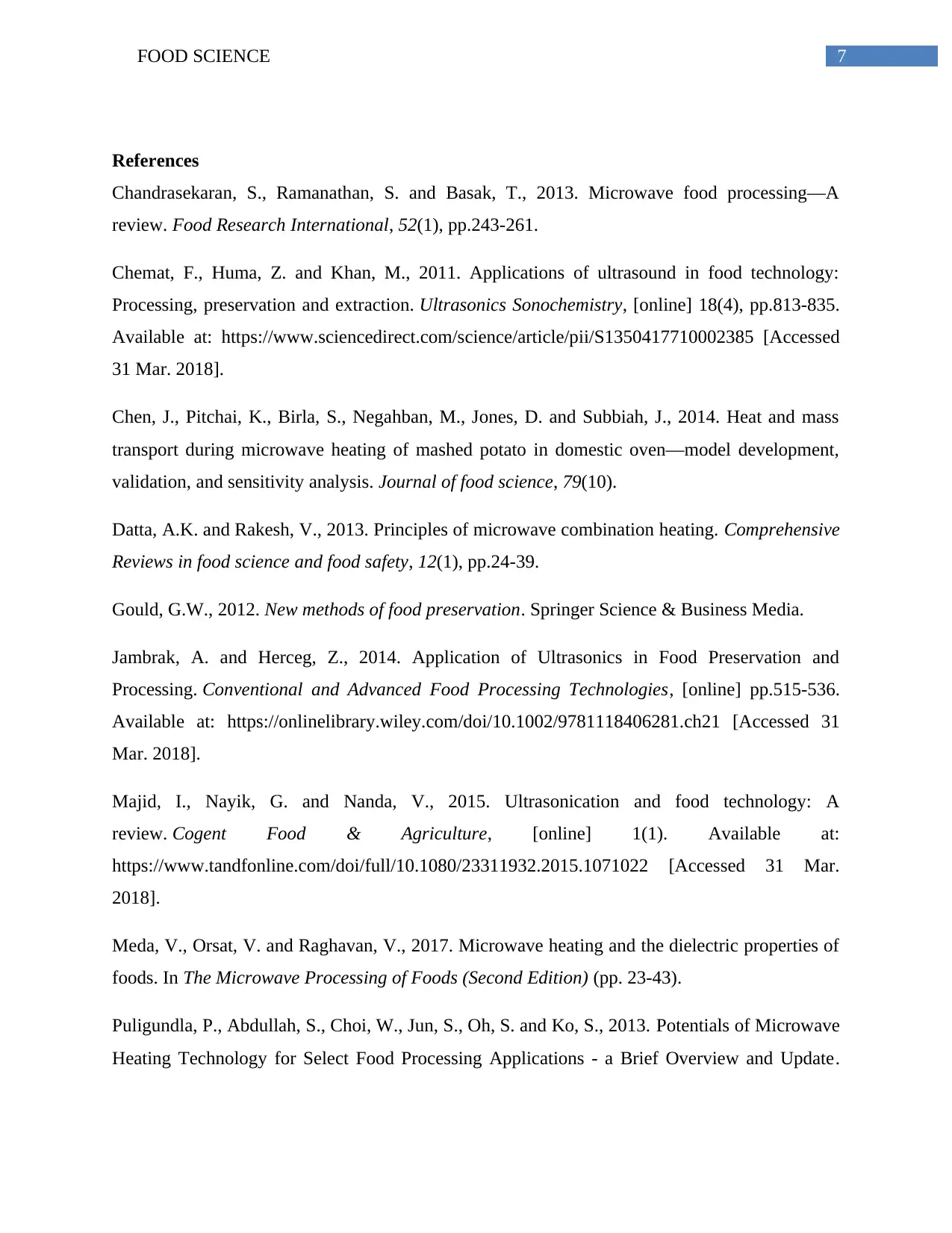
7FOOD SCIENCE
References
Chandrasekaran, S., Ramanathan, S. and Basak, T., 2013. Microwave food processing—A
review. Food Research International, 52(1), pp.243-261.
Chemat, F., Huma, Z. and Khan, M., 2011. Applications of ultrasound in food technology:
Processing, preservation and extraction. Ultrasonics Sonochemistry, [online] 18(4), pp.813-835.
Available at: https://www.sciencedirect.com/science/article/pii/S1350417710002385 [Accessed
31 Mar. 2018].
Chen, J., Pitchai, K., Birla, S., Negahban, M., Jones, D. and Subbiah, J., 2014. Heat and mass
transport during microwave heating of mashed potato in domestic oven—model development,
validation, and sensitivity analysis. Journal of food science, 79(10).
Datta, A.K. and Rakesh, V., 2013. Principles of microwave combination heating. Comprehensive
Reviews in food science and food safety, 12(1), pp.24-39.
Gould, G.W., 2012. New methods of food preservation. Springer Science & Business Media.
Jambrak, A. and Herceg, Z., 2014. Application of Ultrasonics in Food Preservation and
Processing. Conventional and Advanced Food Processing Technologies, [online] pp.515-536.
Available at: https://onlinelibrary.wiley.com/doi/10.1002/9781118406281.ch21 [Accessed 31
Mar. 2018].
Majid, I., Nayik, G. and Nanda, V., 2015. Ultrasonication and food technology: A
review. Cogent Food & Agriculture, [online] 1(1). Available at:
https://www.tandfonline.com/doi/full/10.1080/23311932.2015.1071022 [Accessed 31 Mar.
2018].
Meda, V., Orsat, V. and Raghavan, V., 2017. Microwave heating and the dielectric properties of
foods. In The Microwave Processing of Foods (Second Edition) (pp. 23-43).
Puligundla, P., Abdullah, S., Choi, W., Jun, S., Oh, S. and Ko, S., 2013. Potentials of Microwave
Heating Technology for Select Food Processing Applications - a Brief Overview and Update.
References
Chandrasekaran, S., Ramanathan, S. and Basak, T., 2013. Microwave food processing—A
review. Food Research International, 52(1), pp.243-261.
Chemat, F., Huma, Z. and Khan, M., 2011. Applications of ultrasound in food technology:
Processing, preservation and extraction. Ultrasonics Sonochemistry, [online] 18(4), pp.813-835.
Available at: https://www.sciencedirect.com/science/article/pii/S1350417710002385 [Accessed
31 Mar. 2018].
Chen, J., Pitchai, K., Birla, S., Negahban, M., Jones, D. and Subbiah, J., 2014. Heat and mass
transport during microwave heating of mashed potato in domestic oven—model development,
validation, and sensitivity analysis. Journal of food science, 79(10).
Datta, A.K. and Rakesh, V., 2013. Principles of microwave combination heating. Comprehensive
Reviews in food science and food safety, 12(1), pp.24-39.
Gould, G.W., 2012. New methods of food preservation. Springer Science & Business Media.
Jambrak, A. and Herceg, Z., 2014. Application of Ultrasonics in Food Preservation and
Processing. Conventional and Advanced Food Processing Technologies, [online] pp.515-536.
Available at: https://onlinelibrary.wiley.com/doi/10.1002/9781118406281.ch21 [Accessed 31
Mar. 2018].
Majid, I., Nayik, G. and Nanda, V., 2015. Ultrasonication and food technology: A
review. Cogent Food & Agriculture, [online] 1(1). Available at:
https://www.tandfonline.com/doi/full/10.1080/23311932.2015.1071022 [Accessed 31 Mar.
2018].
Meda, V., Orsat, V. and Raghavan, V., 2017. Microwave heating and the dielectric properties of
foods. In The Microwave Processing of Foods (Second Edition) (pp. 23-43).
Puligundla, P., Abdullah, S., Choi, W., Jun, S., Oh, S. and Ko, S., 2013. Potentials of Microwave
Heating Technology for Select Food Processing Applications - a Brief Overview and Update.
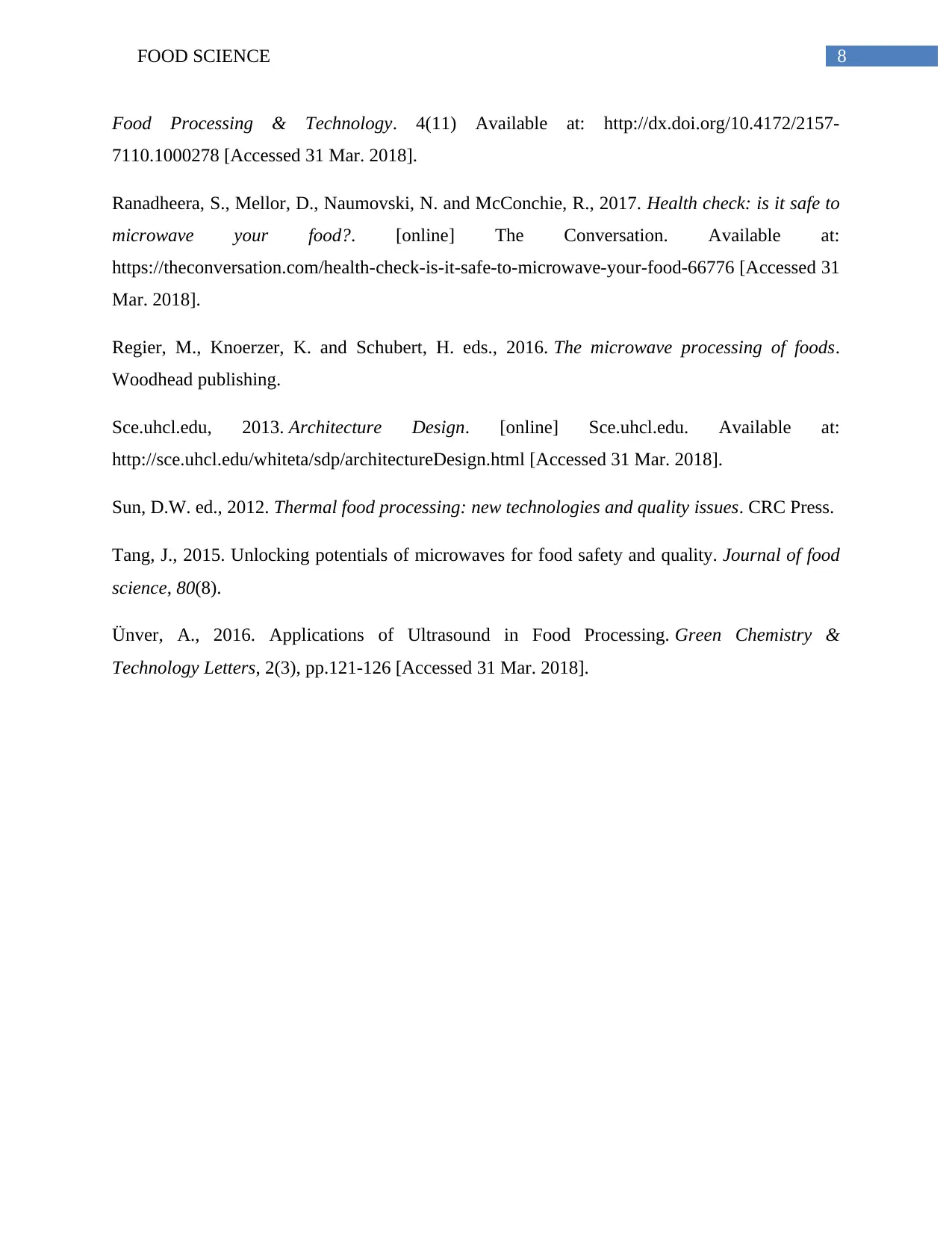
8FOOD SCIENCE
Food Processing & Technology. 4(11) Available at: http://dx.doi.org/10.4172/2157-
7110.1000278 [Accessed 31 Mar. 2018].
Ranadheera, S., Mellor, D., Naumovski, N. and McConchie, R., 2017. Health check: is it safe to
microwave your food?. [online] The Conversation. Available at:
https://theconversation.com/health-check-is-it-safe-to-microwave-your-food-66776 [Accessed 31
Mar. 2018].
Regier, M., Knoerzer, K. and Schubert, H. eds., 2016. The microwave processing of foods.
Woodhead publishing.
Sce.uhcl.edu, 2013. Architecture Design. [online] Sce.uhcl.edu. Available at:
http://sce.uhcl.edu/whiteta/sdp/architectureDesign.html [Accessed 31 Mar. 2018].
Sun, D.W. ed., 2012. Thermal food processing: new technologies and quality issues. CRC Press.
Tang, J., 2015. Unlocking potentials of microwaves for food safety and quality. Journal of food
science, 80(8).
Ünver, A., 2016. Applications of Ultrasound in Food Processing. Green Chemistry &
Technology Letters, 2(3), pp.121-126 [Accessed 31 Mar. 2018].
Food Processing & Technology. 4(11) Available at: http://dx.doi.org/10.4172/2157-
7110.1000278 [Accessed 31 Mar. 2018].
Ranadheera, S., Mellor, D., Naumovski, N. and McConchie, R., 2017. Health check: is it safe to
microwave your food?. [online] The Conversation. Available at:
https://theconversation.com/health-check-is-it-safe-to-microwave-your-food-66776 [Accessed 31
Mar. 2018].
Regier, M., Knoerzer, K. and Schubert, H. eds., 2016. The microwave processing of foods.
Woodhead publishing.
Sce.uhcl.edu, 2013. Architecture Design. [online] Sce.uhcl.edu. Available at:
http://sce.uhcl.edu/whiteta/sdp/architectureDesign.html [Accessed 31 Mar. 2018].
Sun, D.W. ed., 2012. Thermal food processing: new technologies and quality issues. CRC Press.
Tang, J., 2015. Unlocking potentials of microwaves for food safety and quality. Journal of food
science, 80(8).
Ünver, A., 2016. Applications of Ultrasound in Food Processing. Green Chemistry &
Technology Letters, 2(3), pp.121-126 [Accessed 31 Mar. 2018].
⊘ This is a preview!⊘
Do you want full access?
Subscribe today to unlock all pages.

Trusted by 1+ million students worldwide
1 out of 9
Your All-in-One AI-Powered Toolkit for Academic Success.
+13062052269
info@desklib.com
Available 24*7 on WhatsApp / Email
![[object Object]](/_next/static/media/star-bottom.7253800d.svg)
Unlock your academic potential
Copyright © 2020–2025 A2Z Services. All Rights Reserved. Developed and managed by ZUCOL.